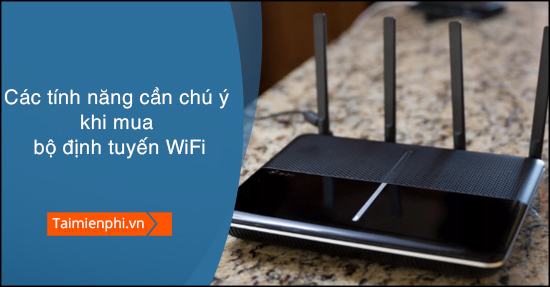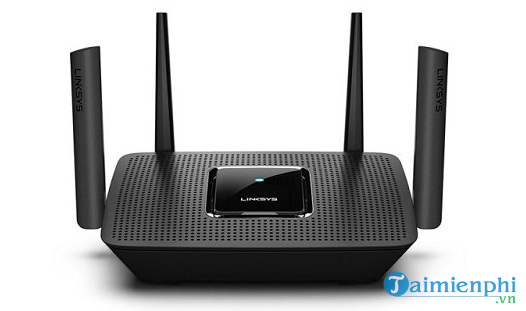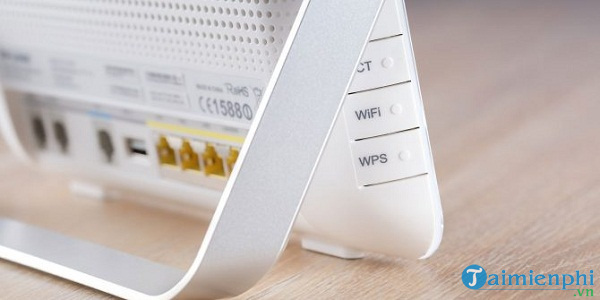Today, wireless routers are no longer a stranger. In offices, restaurants, cafes or restaurants all use this device. Usually, people who buy WiFi routers for home and office use often use the ISP provided for convenience as well as cost savings.

Features to pay attention to when buying a WiFi router
However, problems can occur when too many devices connect to that router. The network may be slow or not reach other areas of your home. In this article, let’s learn the important features to look out for when buying a router.
1. Standard WiFi Router
Along with technology development trends, WiFi router manufacturers have been constantly releasing new and more powerful wireless standards. When considering buying a WiFi router, the first thing you need to check is the WiFi standard it supports. Regular WiFi routers will probably support 802.11b or 802.11g, newer versions support up to 802.11n. Theoretically, a WiFi router that supports 802.11n should let you transfer data at 600mbps (although the speed drops a lot in real-life scenarios).

The latest WiFi standard, 802.11ac allows transfer speeds up to 1.3Gbps. Thanks to this transfer rate, users can connect more devices with high data transfer rate. However, 802.11ac WiFi routers are very expensive, much more expensive than 802.11n routers, and only a few phones and computers are compatible.
2. Wireless frequency router – Single or dual band?
All wireless routers work with two different frequencies – 2.5 GHz and 5 GHz. The main difference between these two frequencies is noise and range. The 5GHz band is generally less prone to interference, and offers a faster connection. 5GHz is a better choice if you plan to connect multiple devices or have overlapping networks in the area. Meanwhile, the 2.5 GHz frequency is prone to interference and congestion, but it comes in at a much cheaper price.
Also, if you are in a densely populated area, a dual-band router is the best choice. A dual-band router is equipped with two radios, one operating at the 2.4GHz frequency and the other running at the 5GHz frequency. A dual band designed to set up two separate wireless networks will help improve speeds in areas with crowded wireless networks.
3. Router antenna limit
For a smooth connection to the router, it is important that the router is centrally located in your home or office, away from physical obstructions and other interference devices. Even so, even from an open location, depending on the router type, you may still experience loss of connection in some areas of your home.
The range of a router cannot be measured directly, it depends on various factors. The only way around this is to look at the router antenna’s dBi rating, which is largely included in the specs.

You can see the device specifications on the back.
If you need a WiFi router for a small apartment, 2-4dBi is enough, but for a large office or a multi-storey apartment, you need a router with a higher dBi rating.
4. MU-MIMO . Antenna
MIMO technology helps your router to transmit signals very quickly by sending data through multiple antennas. With MIMO, a router can target multiple devices (smartphones, tablets, computers) at specific locations at the same time. This is done through another technique called MU-MIMO. However, only routers that support 802.11ac are compatible with MU-MIMO.
To confirm if your router supports MU-MIMO, check your product package or spec sheet. Vendors usually indicate whether the router supports MU-MIMO.
5. Router Security
Wireless networks are not secure because anyone within range can track online activities, hijack the Internet, access files on the device, and infect the device system with viruses. your device.
Today, new model routers may come with many additional security features, including the ability to add encryption, monitor other devices, and block unwanted users from the network, but the Conventional routers are still vulnerable.
When buying a WiFi router, make sure you get one that supports at least the WPA2 security standard. Also, make sure any devices you add to your network support WPA2.
6. Router port
Most routers have a USB port, but for some devices, the USB port is only used to transfer setup information from the router to the guest machine.
The USB ports of the latest WiFi routers allow you to connect a large hard drive to it and any device connected to the network will have access to the resources on that storage. Also, you should consider whether it is a USB 2.0 or 3.0 port. USB 3.0 is a better option as it allows you to connect any kind of accessories.
7. Price
The cost of WiFi routers is mainly determined by their antennas, gateways and other features. The best router with full features costs up to 225 USD. If you only have a tight budget, you can choose the lower versions.
https://thuthuat.taimienphi.vn/nhung-tinh-nang-can-chu-y-khi-mua-bo-dinh-tuyen-wifi-55292n.aspx
To secure your wifi modem at home or at work, you should make a habit of regularly changing your wifi password with long and difficult passwords, maintaining this habit will help your network connection be stable, without delay. due to too many devices connected at the same time and most importantly, your data is safe.
Related keywords:
However, it is essential to be careful when buying wifi routers
the costs when buying a wifi router, buying a main wifi router,
Source link: Features to pay attention to when buying a WiFi router
– Emergenceingames.com
